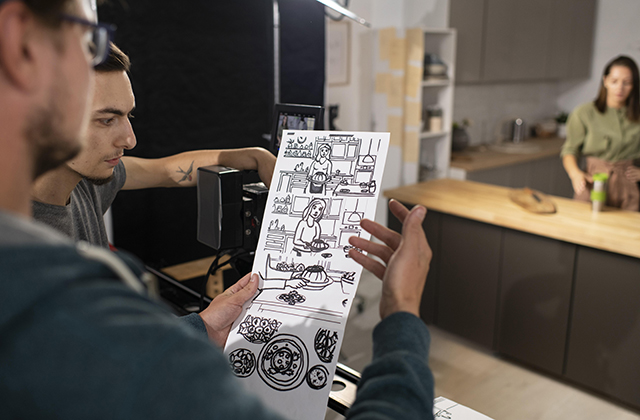The Benefits of Collaboration in Storyboarding: How to Work Effectively with Your Team
Storyboarding is a crucial step in the creative process, whether you’re developing a film, an animated series, or a TV show. It serves as a visual blueprint for your project, helping you plan every scene, shot, and sequence. While many individuals associate storyboarding with solo work, collaborating with your team can yield remarkable benefits. In this article, we’ll explore the advantages of collaboration in storyboarding and offer practical tips on how to work effectively with your team, especially when working on TV storyboard projects.
1. Diverse Perspectives Enhance Creativity
One of the primary benefits of collaborating on a TV storyboard is the diversity of perspectives it brings to the table. When multiple team members contribute their ideas, backgrounds, and experiences, you’re more likely to create a well-rounded and innovative storyboard. Different viewpoints can lead to unexpected solutions and creative breakthroughs that might not have emerged in a solitary process.
Imagine you’re working on a TV storyboard for a crime drama series. Your team includes writers, directors, and cinematographers. Each member brings their unique expertise, and together, you can craft compelling visuals and storytelling elements that captivate your audience. Collaboration fosters an environment where every team member can contribute their ideas freely, leading to a richer and more engaging TV storyboard.
2. Improved Efficiency
Storyboarding can be a time-consuming process, but teamwork can significantly improve efficiency. Dividing the workload among team members allows you to work on multiple scenes simultaneously, reducing the overall project timeline. For TV storyboard projects, this can be particularly advantageous, as episodes often have tight deadlines.
Effective collaboration tools, such as digital storyboarding software, enable team members to work on different aspects of the TV storyboard simultaneously. This simultaneous workflow reduces bottlenecks and accelerates the entire production process, helping you meet your deadlines and deliver high-quality content to your audience.
3. Streamlined Communication
Effective communication is essential for any collaborative project, and storyboarding is no exception. Collaborating with your team promotes clear and constant communication, ensuring that everyone is on the same page regarding the project’s vision, goals, and progress. This is especially important in the context of TV storyboard projects, where intricate details can make or break an episode.
By regularly discussing your ideas, reviewing each other’s work, and providing feedback, you can refine the TV storyboard until it aligns perfectly with your creative vision. Effective communication also helps resolve any conflicts or differences of opinion that may arise during the collaborative process, ensuring a smooth workflow.
4. Enhanced Problem-Solving
Storyboarding often involves solving complex visual and narrative problems. When you collaborate with a team, you can tap into the collective problem-solving skills and expertise of your colleagues. This can be particularly beneficial when facing challenges specific to TV storyboard projects, such as finding the most effective way to transition between scenes or convey emotions through visuals.
By brainstorming and troubleshooting together, you can identify creative solutions to intricate problems, resulting in a TV storyboard that not only meets but exceeds your expectations. The collaborative process encourages a culture of innovation and experimentation, fostering an environment where trying new ideas is encouraged.
5. Increased Accountability
When working alone, it’s easy to lose track of deadlines or overlook important details. Collaborating with a team introduces an element of accountability. Each team member has specific responsibilities, and they are accountable for their contributions to the TV storyboard.
This accountability ensures that everyone is motivated to meet their deadlines and deliver high-quality work. It also reduces the risk of errors or omissions, as multiple sets of eyes are reviewing and revising the storyboard. In the fast-paced world of TV production, where schedules are tight and errors can be costly, accountability is invaluable.
6. Adaptability to Changing Requirements
TV storyboard projects can be dynamic, with changes and revisions often required due to evolving scripts, feedback from stakeholders, or unexpected challenges on set. Collaboration makes it easier to adapt to these changes. Your team can quickly regroup, brainstorm alternatives, and implement necessary adjustments to the storyboard.
Moreover, the collective knowledge and experience of your team members can help you anticipate potential challenges and address them proactively. This adaptability ensures that your TV storyboard remains aligned with the project’s goals and can accommodate last-minute changes without causing major disruptions.
7. Strengthening Team Bonds
Collaborative storyboarding isn’t just about the final product; it’s also an opportunity to strengthen the bonds within your team. As you work together to bring your creative vision to life, you build trust, camaraderie, and a shared sense of achievement. These bonds can extend beyond the current project and contribute to a more harmonious and productive working environment in the future.
In conclusion, collaboration in storyboarding, especially in TV storyboard projects, offers numerous benefits, including enhanced creativity, improved efficiency, streamlined communication, enhanced problem-solving, increased accountability, adaptability to changing requirements, and stronger team bonds. By harnessing the power of collaboration, you can create TV storyboards that not only meet but exceed your creative goals, ultimately delivering compelling content to your audience. So, gather your team, embrace collaboration, and let your collective creativity shine through in your next TV storyboard project. Visit the existing projects that we had for storyboarding.


